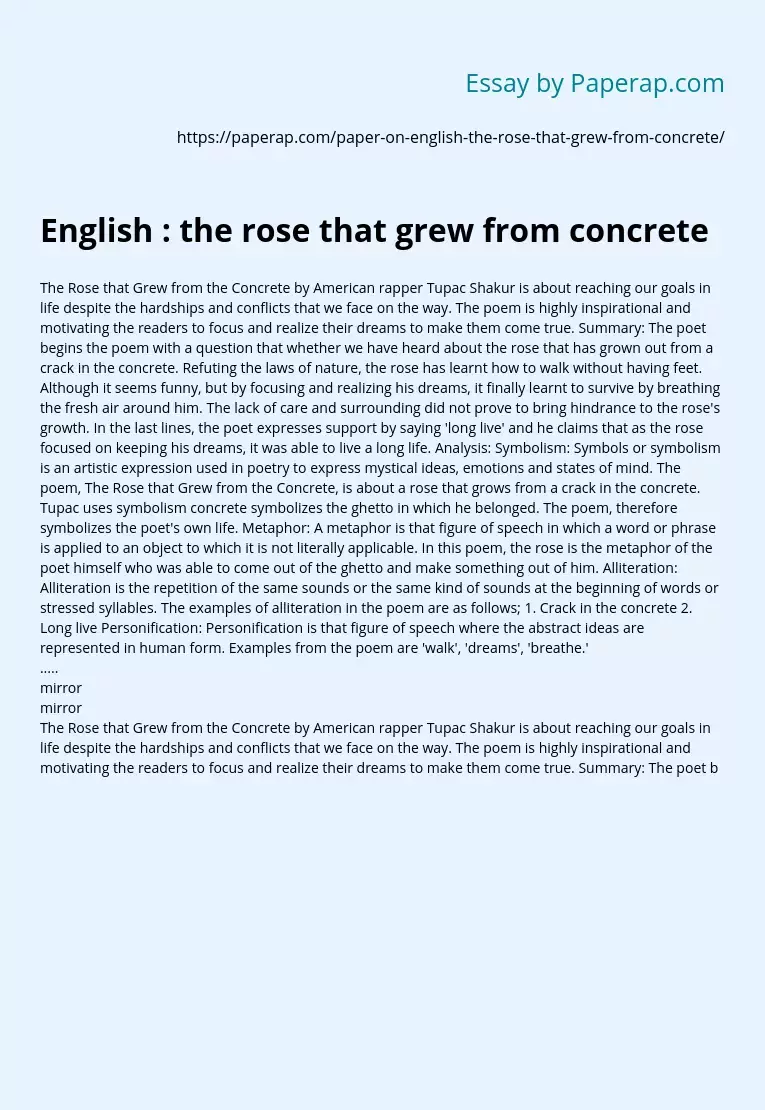English : the rose that grew from concrete
Summary:
The poet begins the poem with a question that whether we have heard about the rose that has grown out from a crack in the concrete. Refuting the laws of nature, the rose has learnt how to walk without having feet.
Although it seems funny, but by focusing and realizing his dreams, it finally learnt to survive by breathing the fresh air around him. The lack of care and surrounding did not prove to bring hindrance to the rose’s growth. In the last lines, the poet expresses support by saying ‘long live’ and he claims that as the rose focused on keeping his dreams, it was able to live a long life.
Analysis:
Symbolism: Symbols or symbolism is an artistic expression used in poetry to express mystical ideas, emotions and states of mind. The poem, The Rose that Grew from the Concrete, is about a rose that grows from a crack in the concrete. Tupac uses symbolism concrete symbolizes the ghetto in which he belonged. The poem, therefore symbolizes the poet’s own life.
Metaphor: A metaphor is that figure of speech in which a word or phrase is applied to an object to which it is not literally applicable.
In this poem, the rose is the metaphor of the poet himself who was able to come out of the ghetto and make something out of him.
Alliteration: Alliteration is the repetition of the same sounds or the same kind of sounds at the beginning of words or stressed syllables. The examples of alliteration in the poem are as follows;
1. Crack in the concrete
2. Long live
Personification: Personification is that figure of speech where the abstract ideas are represented in human form. Examples from the poem are ‘walk’, ‘dreams’, ‘breathe.’
Summary:
The poet begins the poem with a question that whether we have heard about the rose that has grown out from a crack in the concrete. Refuting the laws of nature, the rose has learnt how to walk without having feet. Although it seems funny, but by focusing and realizing his dreams, it finally learnt to survive by breathing the fresh air around him. The lack of care and surrounding did not prove to bring hindrance to the rose’s growth. In the last lines, the poet expresses support by saying ‘long live’ and he claims that as the rose focused on keeping his dreams, it was able to live a long life.
Analysis:
Symbolism: Symbols or symbolism is an artistic expression used in poetry to express mystical ideas, emotions and states of mind. The poem, The Rose that Grew from the Concrete, is about a rose that grows from a crack in the concrete. Tupac uses symbolism concrete symbolizes the ghetto in which he belonged. The poem, therefore symbolizes the poet’s own life.
Metaphor: A metaphor is that figure of speech in which a word or phrase is applied to an object to which it is not literally applicable. In this poem, the rose is the metaphor of the poet himself who was able to come out of the ghetto and make something out of him.
Alliteration: Alliteration is the repetition of the same sounds or the same kind of sounds at the beginning of words or stressed syllables. The examples of alliteration in the poem are as follows;
1. Crack in the concrete
2. Long live
The critic Jo Gill writes of “Mirror” that even as the mirror straightforwardly dThe second stanza is significant because it, as Gill explains, “exposes…the woman’s need of the mirror [and] the mirror’s need of the woman.” When the mirror has nothing but the wall to stare at, the world is truthful, objective, factual, and “exact,” but when the woman comes into view, the world becomes messy, unsettling, complicated, emotional, and vivid. Thus, the mirror is “no longer a boundary but a limninal and penetrable space.” It reflects more than an image – it reflects its own desires and understanding about the world.
Overall, “Mirror” is a melancholy and even bitter poem that exemplifies the tensions between inner and outer selves, as well asindicates the preternaturally feminine “problem” of aging and losing one’s beauty
escribes itself as “silver and exact,” it feels compelled to immediately qualify itself. Gill writes, “as the poem unfolds we see that this hermetic antonym may be a deceptive facade masking the need for communion and dialogue.” The mirror actually dominates and interprets its world, and thus has a lot more power than it seems to suggest. It does not merely reflect what it sees, but also shapes those images for our understanding. Gill notes that the poem is catoptric, meaning that it describes while it represents its own structure; this is down through the use of two nine-line stanzas which are both symmetrical, and indicative of opposition
English : the rose that grew from concrete. (2017, Nov 30). Retrieved from https://paperap.com/paper-on-english-the-rose-that-grew-from-concrete/

